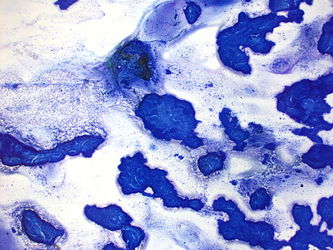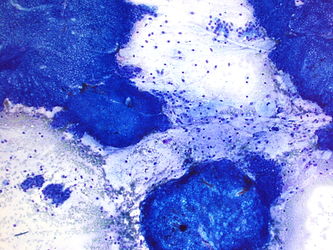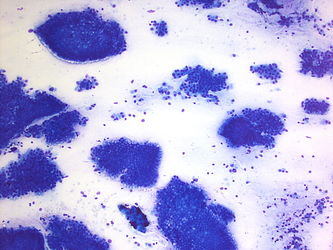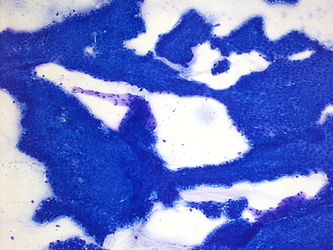From Pathology Education Instructional Resource
|
|
| Line 1: |
Line 1: |
| | + | ==Clinical History== |
| | + | 58 year old female with a pancreatic mass. |
| | + | |
| | ==Cytology== | | ==Cytology== |
| | <gallery heights="333px" widths="333px"> | | <gallery heights="333px" widths="333px"> |
Latest revision as of 20:10, 16 January 2014
Clinical History
58 year old female with a pancreatic mass.
Cytology
Resident Questions
- Mucinous Pancreatic Neoplasm
- Includes two diagnostic entities:
- Mucinous Cystic Neoplasm (MCN)
- Most arise in the body and tail of the pancreas
- Most occur in women between the ages of 40 and 50 years old
- Do not arise from the pancreatic main duct
- Intraductal Papillary Mucinous Neoplasm (IPMN)
- Most arise in the head of the pancreas
- Most occur in men older than 60 years old
- Connect to the pancreatic main duct or one of its branches
- Radiology shows dilatation of the pancreatic duct and its branches
- Endoscopy will reveal thick mucin extruding from the ampulla
- Both are considered high risk due to their association with dysplasia and underlying carcinoma
- Distinction between the two on cytology alone is not recommended
- Best diagnosis is "neoplastic cells present, pancreatic mucinous neoplasm"
- Abundant thick mucin that may look colloid like
- Mucin can be so thick and tenacious it may cause difficulty in aspirating and making smears
- Flat sheets and clusters of bland appearing columnar cells with abundant intracytoplasmic mucin
- Mucin fills the cytoplasm and displaces the nucleus to the periphery or base of the cell. This is unlike the apical mucin seen in gastric foveolar epithelium
- Atypia may be present depending on the presence and degree of dysplasia
- Single cells or groups trapped in mucus
- Contaminant gastrointestinal
- Brush border and interspersed goblet cells is seen in duodenal epithelium
- May see abundant mucin from GI tract
- Gastric epithelium is present in tissue fragments of uniform cuboidal cells
- Punctate perinuclear staining with B72.3
- CAN NOT DIFFERENTIATE BETWEEN IPMN AND MCN ON CYTOLOGY ALONE
- CEA levels are >200ng/mL in both MCN and IPMN
- Amylase will be high in IPMN and low in MCN (due to IPMN connection with the pancreatic duct)
- B72.3 has diffuse cytoplasmic staining in MCN and IPMN





